
archives for 04/2017
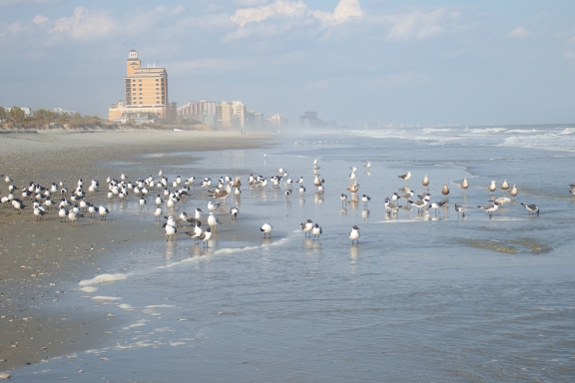
Despite the outpouring
of support from our kind readers (thank you!), Lucy's death so quickly
on the heels of Artemesia's sent me and Mark reeling. On a whim, we
filled extra feeders and waterers for the animals left behind, hopped
in the car, and drove to the very closest beach to our farm --- Myrtle.

The oceanfront suite we
nabbed at a steep discount felt strangely private despite being one of
hundreds at Forest Dunes. Even better, opening the door onto our hefty
balcony let in the sights, smells, and sounds of the sea. This is the
closest I've ever slept to the beach and I reveled in snoozing to the
soundtrack of waves breaking against the shore.

Watching the sun rise
from my bed was quite a treat as well.
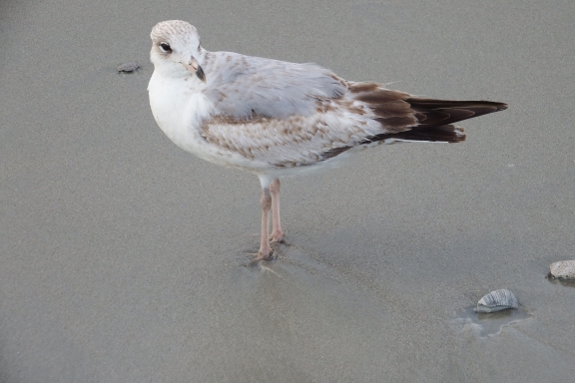
Of course, Myrtle Beach
isn't a very natural seashore. Wildlife sightings consisted of scads of
gulls (three different species), a couple of plovers, a fish crow or
two, and a few flocks of pelicans. Despite all that, I thoroughly
enjoyed four long walks on the beach and one cold but invigorating swim
in the ocean. Really, just sitting on that balcony would have been
enough to make the drive worthwhile.

Two nights was just long
enough to remind us that the world is full of peace and joy before we
drove back to our waiting farm. Despite our ancient car, which finished
the drive held together by two long pieces of gaffer's tape and a
dilapidated shoelace, we feel so grateful to have chosen a lifestyle
that allows us to take the time we need to fill the hole in our hearts.
And thank you for following along on our journey!
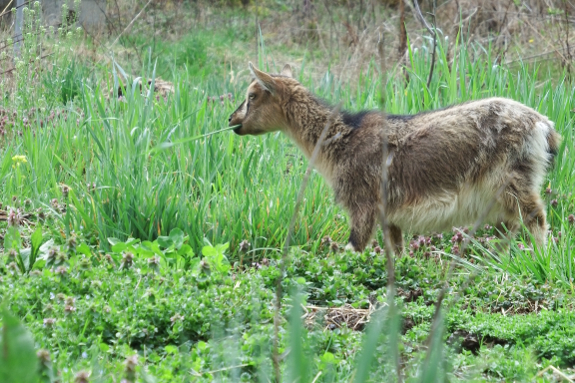
For the last month, I've
been going through the motions with our goats --- feeding them, letting
them out to graze, but not really allowing them deeply into my heart.
Artemesia's loss was just too raw to consider repeating that experience
anytime in the near future.
 But there's no point in
including optional activities into your life unless you embrace them
fully. So, after much soul-searching, I've decided to commit and try to
make our herd back into a thing of beauty and joy.
But there's no point in
including optional activities into your life unless you embrace them
fully. So, after much soul-searching, I've decided to commit and try to
make our herd back into a thing of beauty and joy.
Mostly, the decision is
just a trick of the mind. But there will also be some changes involved.
First --- our little wether (who has become the herd
boss despite his minuscule size!) needs to learn to walk on a leash, to
have his hooves clipped, and in general not to shy away from my
approach. Next, we're gonna lick this
parasite problem,
starting with diatomaceous earth (already applied), ramping up to
shaving, then hitting the chemical insecticides if necessary. And,
finally, I'm putting our preordered
doeling onto my list
of things I'm anticipating with honest pleasure. Wanna help me dream up
a name for a little, floppy-eared goat due to be born in the next week
or so?
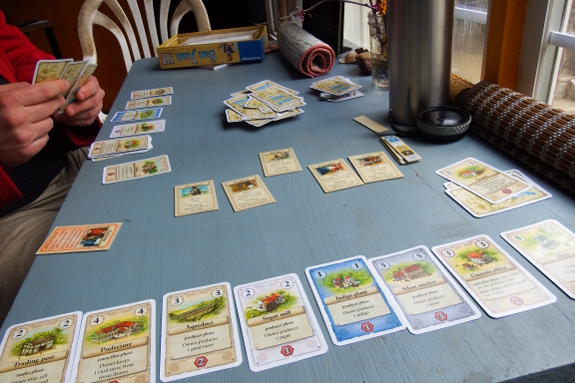
Joey came over Saturday
with a new card game to play. San Juan really hit the
spot since it's fast and simple enough not to feel like a big
commitment but complicated enough not to bore you after one or two
iterations.
I feel so lucky that my
brother gives
talks at
conferences all over the world just to be introduced to
board games I might enjoy. (That is the purpose, right?) Please keep
Cory Doctorow's cold to yourself, though. Thanks!
The goats spend most of their
time in the barn on a rainy Monday like today.
A good time to catch up on
hoof trimming.
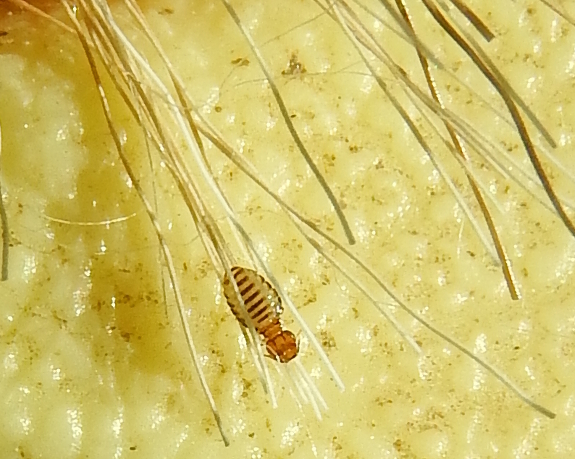
The first step in
dealing with Aurora's
biters was to figure out what exactly is chewing on her. After
combing through her hair in bright sunlight for a while, I finally
discovered small, slow-moving brown spots. Clipping a bit of hair plus
biter then photographing and zooming way in on the resultant image
resulted in a diagnosis --- biting lice (Bovicola
caprae/Damalinia caprae).
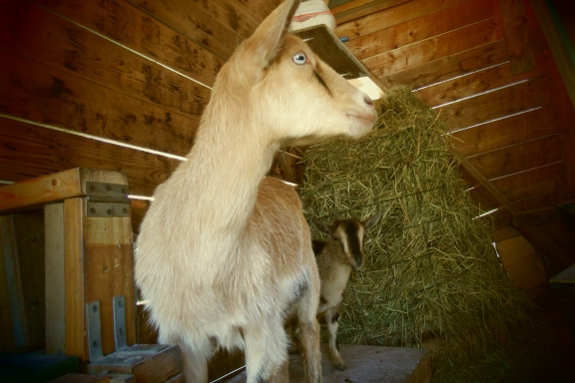
Various natural
treatment methods exist for lice on goats, but all either seem too
invasive to me or have proven ineffective. On the ineffective front,
diatomaceous earth did absolutely nothing to hinder Aurora's lice
despite brushing gobs of it into her hair for multiple days running. On
the invasive front, soaking your animal in any liquid (including water)
and keeping her wet for six hours will kill nearly all lice...good luck
with that. Shearing is also effective at removing 30 to 50% of lice,
with most of the rest naturally dying as they're exposed to
weather...but we have a cold spell coming up and I don't think our
goats would enjoy being sheared.
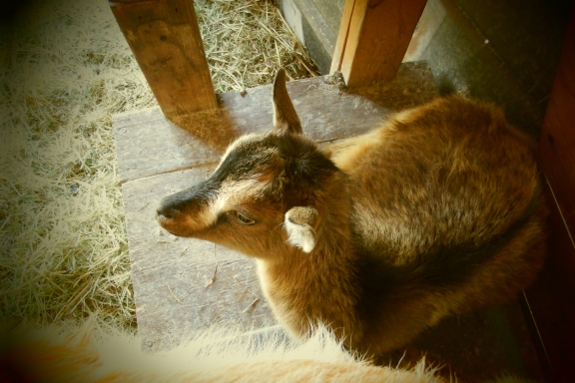
So, chemicals it is. The
internet is mixed on mainstream methods of treatment, but one extension
agent site says that the ivermectin or moxidectin dosages that work on
sucking lice aren't effective against biting lice. Instead, they
recommend treating with permethrin, which comes in various brand names
and application patterns. Of these, Ultra
Boss is labelled for
use on goats as a pour-on (meaning you can apply in a strip down the
animal's back like cat or dog flea meds). That seems the least
invasive, so we're going to give it a shot --- treat once, then wait
two weeks and treat again. Fingers crossed poor Aurora will stop
stamping and scratching in the near future.
I made the walls for the
wheelchair chicken tractor out of green
plastic fencing.
It bends and rubs against the
grass to keep predators out and the chickens in.
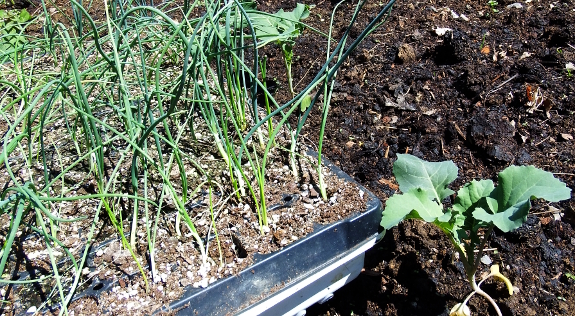
Even though Dogwood
Winter is coming up this weekend, I decided to go ahead and set out my
flat of onion seedlings to join the broccoli I transplanted early last
week. Friday's task will be covering all and sundry with row covers so
the freeze doesn't nip tender leaves. Here's hoping the forecast low of
32 doesn't go below 28 --- fruit blossoms would appreciate a reprieve!
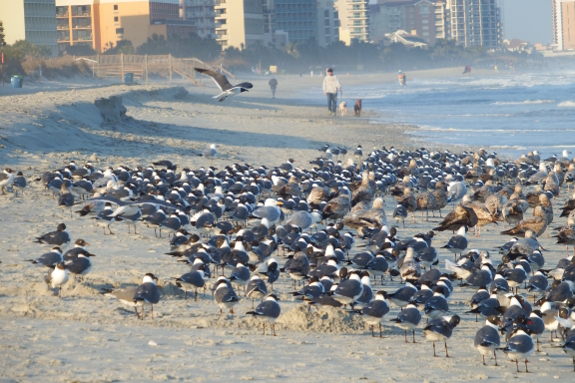
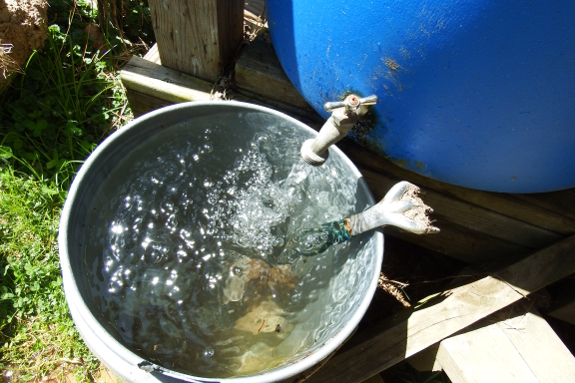
I meant to drain the rain
barrel last fall.
But we were still using it, and every time I let the water run out Mark
came along behind me and closed the spigot. I never remembered to tell
him that it's good practice to leave the rain barrel empty for the
winter, and at some point I just shrugged and let it ride.
And here's the deal ---
nothing froze and broke. Now I'm wondering if winterizing the rain
barrel is just one of those tasks people tell you to do that aren't
really necessary. In fact, we enjoyed having the easily accessible
outdoor winter water for goats, chickens, and for the aquaponics setup.
So maybe next year I won't even put that task on my to-do list.
How about you? Do you
drain your rain barrel for the winter? If not, have you had any
problems as a result?
A recycled swimming
pool makes for a decent chicken tractor roof.
A metal roof would've weighed
too much.
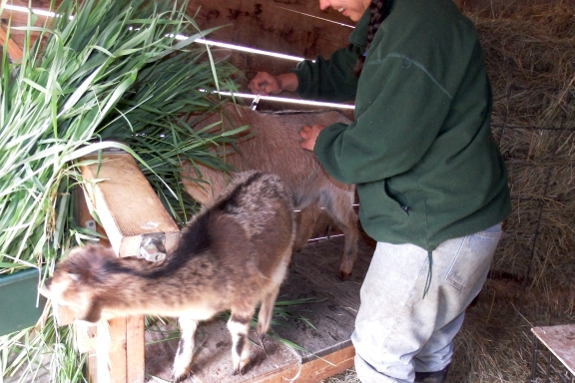
The quart of Ultra Boss
we bought to deal with our
goats' lice comes with a measurer in the bottle. But the product is
more geared toward cattle than goats, so I decided to use a syringe
instead to ensure I dosed our doe and wether correctly. Aurora got 2 mL
of insecticide dripped along her back while tiny Edgar got only 1 mL.
Hopefully a repeat in two weeks will kill any lingering biters and will
leave our herd once more in tip-top condition.
Anna and I wanted to thank
David Hicks for his astute comments and for clicking on the monthly donate
button in our store link.
We really appreciate the
value you put into the Walden Effect.
We were just talking this
afternoon about how we plan to use some of the funds to try out a new
Roll Out nest tray product that will slide into the bottom of the above
plywood box for the wheelchair chicken tractor project.

Jennifer snapped this
sighting of Weekend Homesteader in the wild at her local
library. It made my day to see my 4.5-year-old book still plugging
along and guiding new homesteaders, especially since my goal this year
is to get back to basics and focus more on the tried and true.

Nayan makes a good point in
her latest comment.
"My neighbor had made a heavy-duty
tractor with hardware cloth etc. and
it was pretty heavy. The raccoons got into it anyhow and ate every...
single... adult... chicken. How you do keep predators away?
We have come to the
conclusion that the risk is worth the value for better quality eggs. If
the predator pressure gets too high then maybe we'll build a Fort Knox
type of chicken coop and bring bugs to the chickens which will involve
another level of time and effort.
Image credit goes to flickr
user garyjwood.
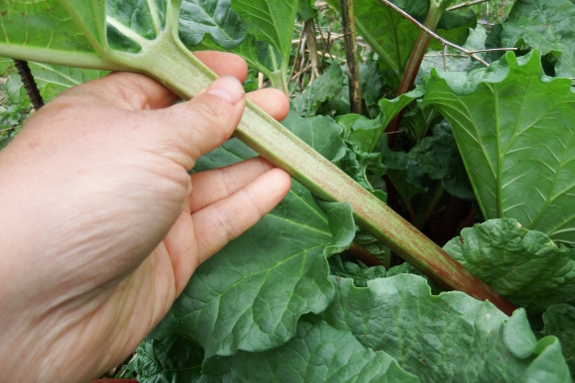
While covering up
strawberries and spring seedlings in preparation for a freeze, I
suddenly couldn't recall whether or not lush new rhubarb growth needs
to be protected. So I headed to the internet for an answer.
What I found was
information I hadn't been looking for. Did you realize that the
problematic oxalic acid in the leaves of rhubarb moves down into the
stems during freezes? In other words, even if you don't need to cover
the plants during spring freezes (which seems to be the case --- no
visible damage at 27 degrees), you might want to pick any stems you're
interested in eating beforehand. Rhubarb crumble --- a new tradition
for Dogwood Winter.
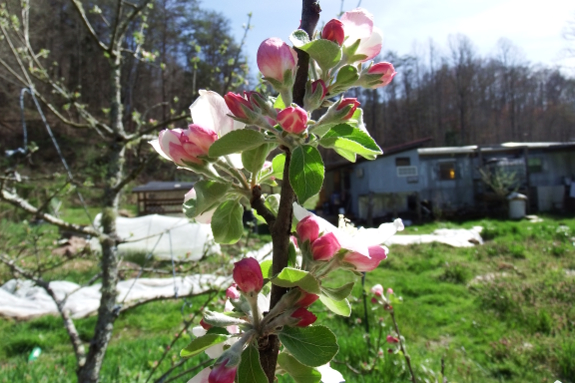
I think we might have
gotten lucky with this current cold snap. Only the William's
Pride apple blossoms
were open, and enough flowers remained unfurled that even that variety
will likely still set fruit.
Now to start crossing
our fingers that we can weather one more month with no hard freezes cold
enough to nip incipient fruit. The long-range weather
forecast is looking good, but who knows what might change between now
and May 15!
The wheelchair chicken tractor is designed to dock up to a moveable rectangle run that can be moved each morning along with the tractor.
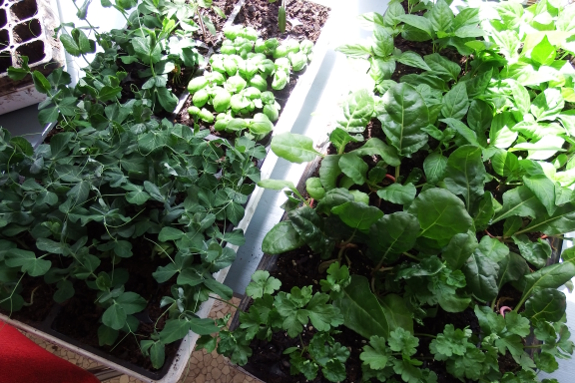
With the frost danger
past, it's time to set out the rest of the cold-hardy seedlings.
Everything pictured above hit the garden Monday except the basil and
peppers. The peas were a bit root-bound, but I'm hoping they'll expand
out into new ground anyway. In a few weeks, I'll have to check back and
see if I can tell the difference between the
direct-seeded peas and the transplanted starts that I used to fill in
the gaps.
This new roll out nest tray
was 22 dollars with shipping.
It's got an angle that makes
eggs roll out into the tray under the flap.
It's part of a plastic nest
box with a perch but I wanted to build my own box.
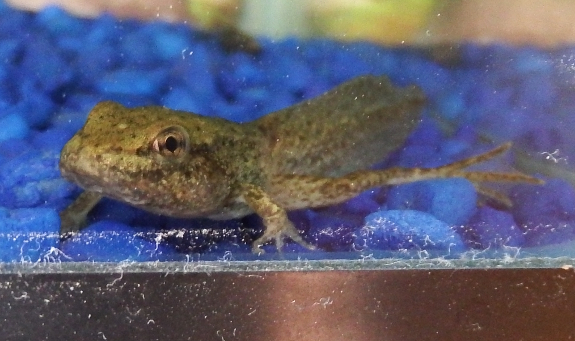
One of my Green
Frog tadpoles
started transforming on me late last week. I'd actually barely seen the
tadpoles since they tended to hide in the fake vegetation, steering
clear of the more active fish. But as this guy grew legs, he came out
to visit the front of the tank.
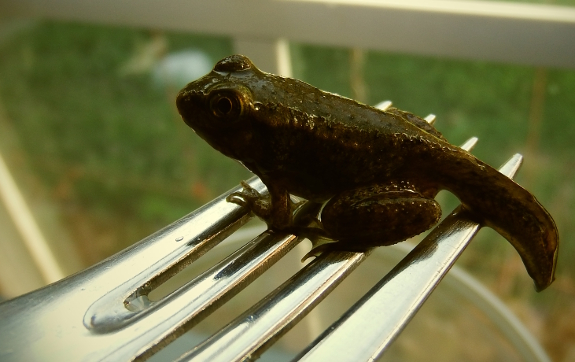
Then, Tuesday morning,
he was treading water at the surface. "I have lungs now!" he told me.
"Give me somewhere to crawl out and hop around!"
Rather than changing the
tank itself, I fished the baby frog out with a fork and gave him a sky
pond to hang out in. Looks like warm, high nutrient water was all he
needed to beat the rest of his species at transformation by two solid
months.
I managed to get the Kubota
stuck yesterday in the same place it was stuck before.
It only took about a half
hour to haul the Super Winch to the spot and pull us out.
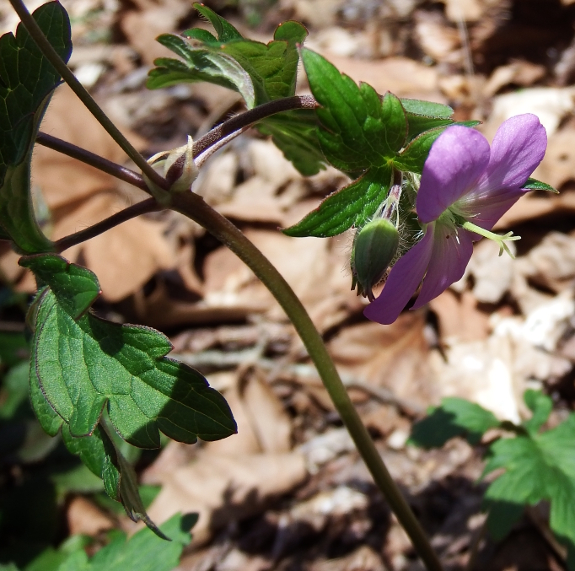
Hot weather followed
directly behind last week's cold spell. Suddenly, leaves and flowers
were springing out all over, so I grabbed my camera and prepared to
document the show.
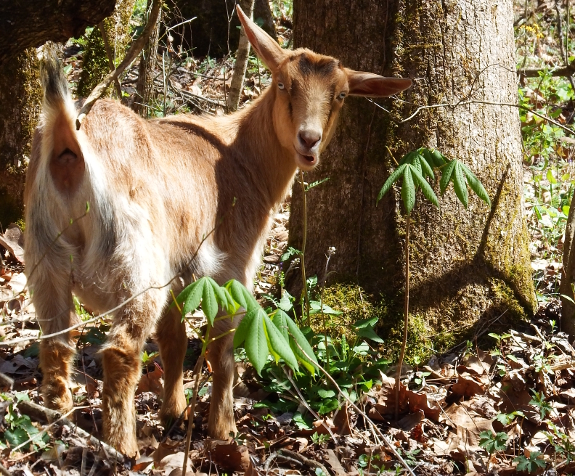
Unfortunately, I made
the mistake of bringing the herd along with me. "What fun!" said
Artemesia, gnawing on frost-sensitive buckeye leaves that miraculously
survived Dogwood Winter. The trouble with going out to photograph
nature with goats on your heels is you have to act fast or they'll eat
your subject matter.
I recycled some fabric off an old shade umbrella to keep our chickens cool inside.
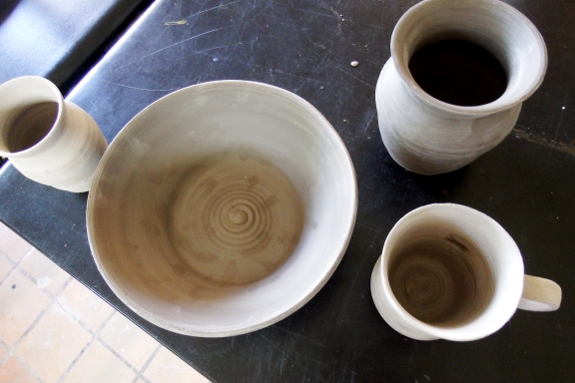
Less than a month later,
clay class is over --- I'm so sad to
see it go! Six sessions on the wheel was just long enough for me to
remember how to create vessels of various shapes and sizes, but not
long enough to get the itch out of my system. Here's hoping Mark can
get the rusted guts of a kick wheel out by the barn up and running
before I go into withdrawal.
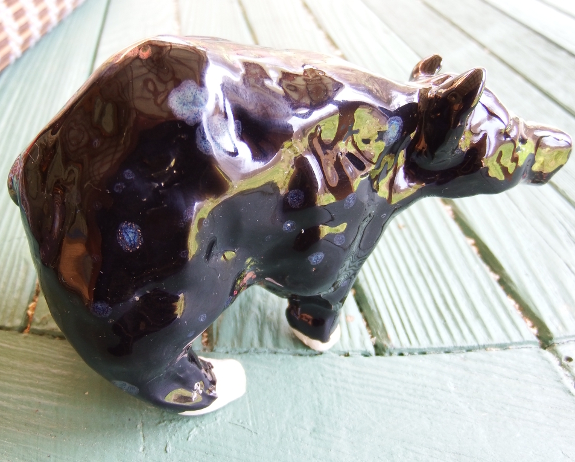
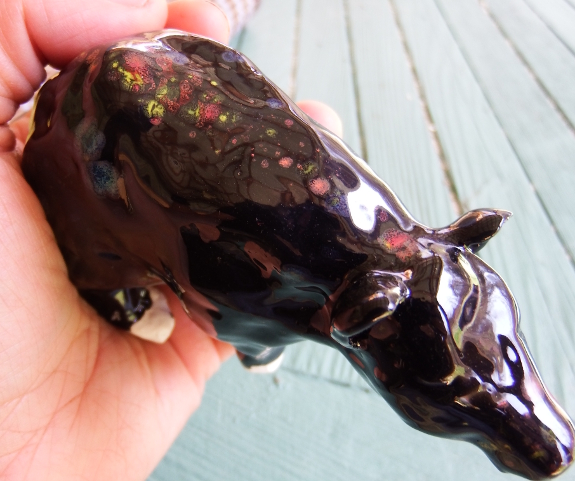 I
did a little hand-building too, but most of those pieces haven't yet
been fired. One of my earliest efforts, a little black bear, came out
nicely...but is about as hard to photograph as Huckleberry. I'll see if
I can't get better shots of my other pieces once they're glazed and
done.
I
did a little hand-building too, but most of those pieces haven't yet
been fired. One of my earliest efforts, a little black bear, came out
nicely...but is about as hard to photograph as Huckleberry. I'll see if
I can't get better shots of my other pieces once they're glazed and
done.
The addition of a front handle makes the wheelchair chicken tractor easier to pull than to push by making it easy to lift the front up an inch.
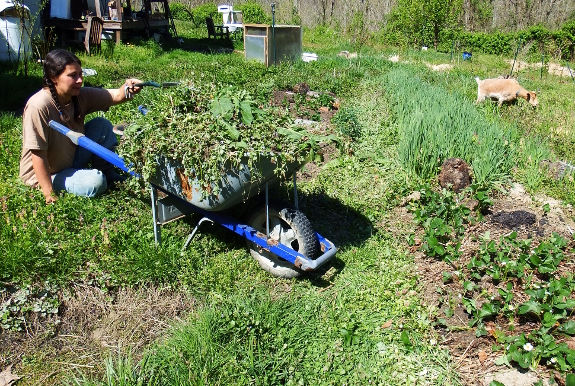
This is the time of year
when our farm undergoes its own sort of time change. Afternoons are
already getting too hot to make outdoor work fun. So we swap our inside
and outside tasks, taking to the garden before lunch and enjoying
interior cool during the sweltering afternoons. I may even have to hook
up the sprinklers shortly if this hot spell continues!
The wheelchair tractor roof
latches in the front so it can open for easy access.
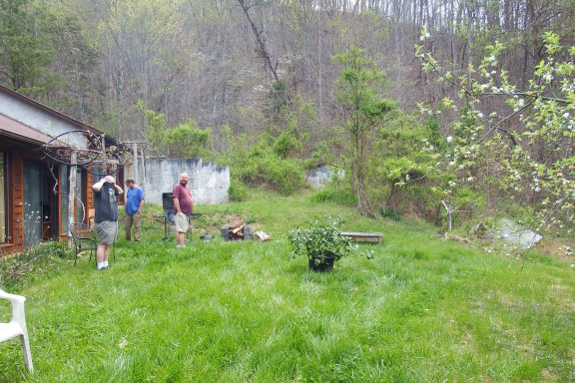
Joey hosted an awesome
late birthday/housewarming party Saturday. Much fun was had by all,
although some of the participants were a little camera shy.
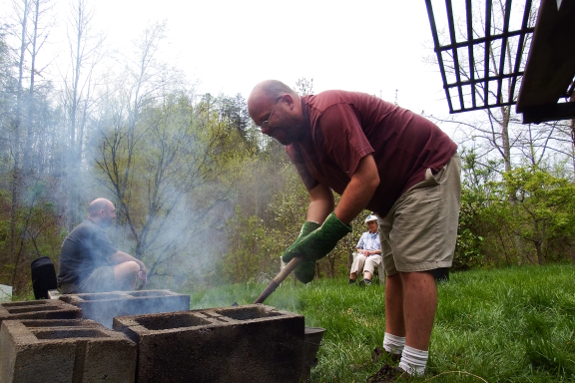
The food was also the
entertainment, courtesy of Joey's homemade
charcoal.

I mostly ran around
enjoying the soft spring grass, which seems about a week further along
than it is on our farm. But I took time out to enjoy Maggie's banjo
plucking and to visit with friends and family new and old.
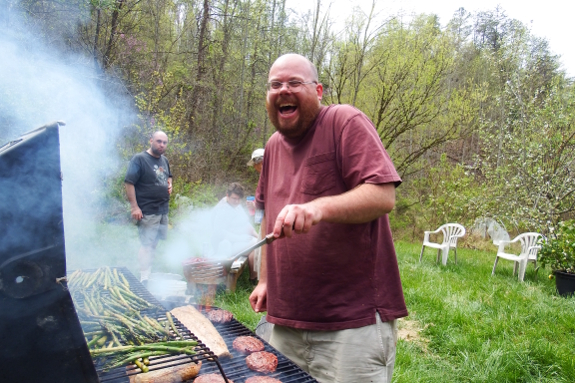
Thanks for the
invitation, Joey...and for being a good sport about letting me put
multiple photos of you up on the blog.
Anna's brother Joey offered
to give us his greenhouse frame if we break it down and haul it off.
The pieces seem to break
apart into sections you can fit into a truck.
I think it's a project that will be late Summer or Fall.
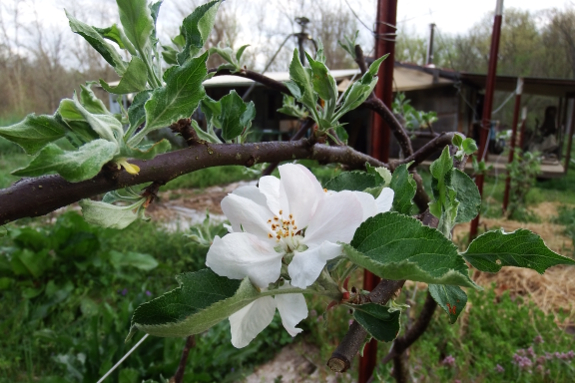
Those of you considering
variety and rootstock selection for apples might get a kick out of some
numbers from our three-year-old apple espaliers. These trees were all
grafted by me in April 2014, then they
were set out into their forever homes that fall. Here's the data:
- Dead: Liberty (M7), King David (M7), Kidd's Orange Red (M7)
- Not doing well: Honeycrisp (MM111)
- Blooming: Winesap (M7), Early Harvest (MM111)
- Good but vegetative: Pound Pippin (MM111), Red Delicious (MM111), Wolf River (MM111), Winesap (MM111), Chestnut Crab (M7)
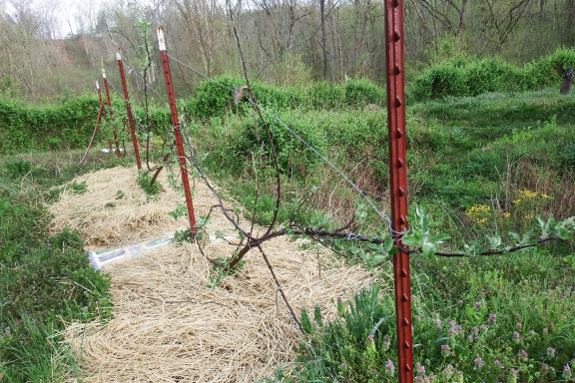
Based on this data, I
suspect that M7 rootstock isn't quite cold hardy enough for our farm,
at least not if I plant up against the hillside where very little
winter sun hits. On the other hand, I wouldn't be surprised if the M7
Winesap is an early bloomer because of its rootstock (as opposed to the
Early Harvest, which is noted for precocious bearing).
Honeycrisp, if I recall
correctly, was hit hard by cedar
apple rust last summer. I think I meant to pull the tree out,
actually, but it was granted a stay of execution until this year.
That's a variety problem not a rootstock problem, and despite how much
Mark loves the apples, I wouldn't plant a Honeycrisp again in a
no-spray orchard.
The other varieties seem
vigorous and happy. Maybe next year, even those on MM111 will bloom!
The new PVC chicken run for the wheelchair chicken tractor is 10 feet long and 3 feet wide.
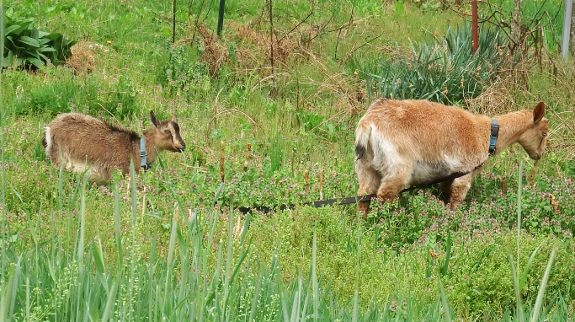
We're making slow but
sure progress with Edgar. Delousing was quite effective, with
his fur finally starting to look less rough and scraggly. I suspect the
kelp he's been scarfing like candy might also be implicated in his more
healthful appearance.
Meanwhile, we were able
to trim his hooves relatively easily (although it was a two-person job)
and he's okay with a leash now 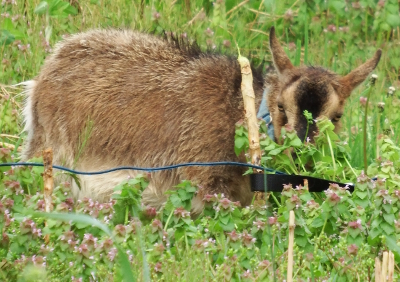 (although
he gets scared every time I put one on). These are definitely moves in
the right direction.
(although
he gets scared every time I put one on). These are definitely moves in
the right direction.
On the other hand, our
little wether is still far from the health level I expect in my goats.
He came with a slight cough, which is still present, and his manure has
never come out in solid pellets the way it should. Both could be
symptoms of various kinds of worms...or could be as simple as allergies
and eating too much lush spring greenery.
Regardless, copper is next on my treatment regimen, and the fresh
browse that is starting to fill most of his diet should help with
general body tone. Maybe in another month, skittishness will be the
only factor proving that Edgar wasn't always our goat.
A rope on each end of the PVC chicken run will make it easy to pull into place.
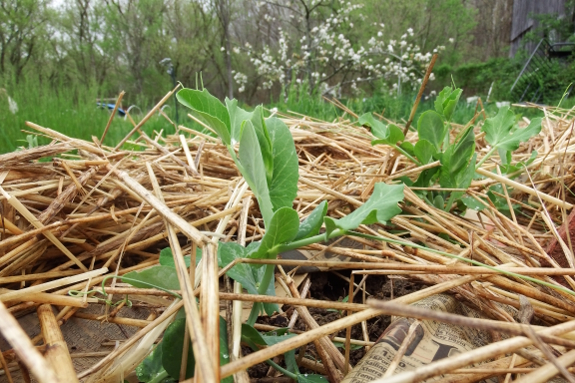
Every day this week has
offered what I like to call "seedling rain." Less than a quarter of
inch of liquid falling over the course of twenty-four hours, the gentle
drizzle and overcast conditions perfect for baby vegetables.
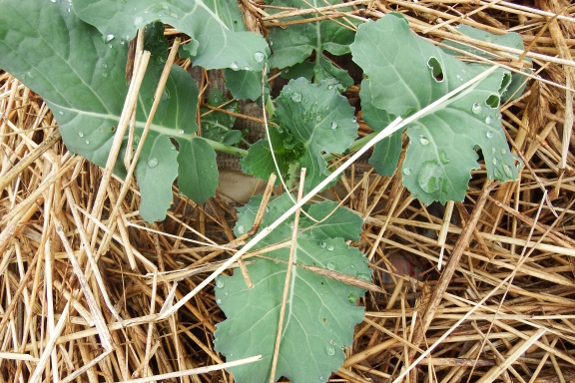
The conditions tempt me
to transplant rather than pot up the rest of the seedlings still stuck
under lights indoors. But we have four solid weeks until our frost-free
date and I don't trust the long-range forecast enough to set out
tomatoes, peppers, and basil. Instead, I just watch the gentle rain
perk up March-transplanted peas and broccoli and enjoy the ground
getting a little easier to weed.
After much research we
decided to go with a Honda self propelled lawn mower.
We got it at Home Depot which
started giving military discounts like Lowes.
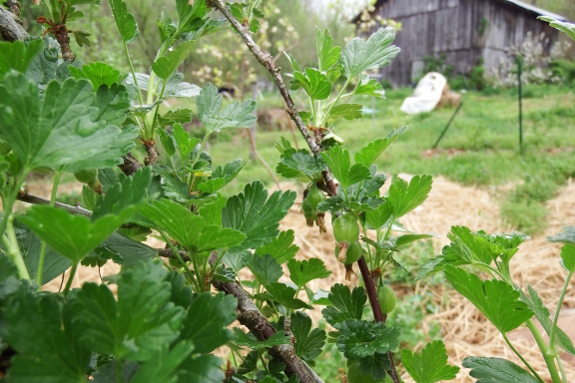
When I moved
the surviving blueberries and gooseberries downhill from the
ultra-shady spot where they originally lived, I was a bit concerned that
such mature bushes wouldn't survive being transplanted. So I pruned
them harder than usual, removing perhaps a third of the top growth.
Then I waited to see what would happen.
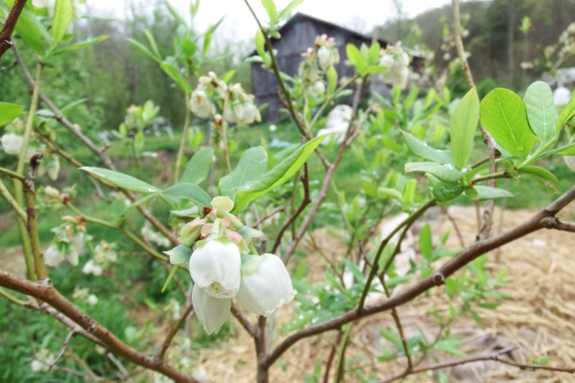
So far, so good. The
plants old enough to bear fruit are indeed blooming copiously and the
tender new leaves show no problems yet. It'll be awfully nice to have
the fruit so close to the back door for daily picking, and I can
already tell I'm going to get three times the pleasure despite cutting
the planting size back by a factor of four. Now that's math I can get
behind.
The new Honda mower was easy to set up and
even easier to start.
Anna got it going on the
first pull with little effort.
The bigger wheels and extra
power is a good match for our overgrown patches of weeds we like to
call a lawn in between sections of the garden.
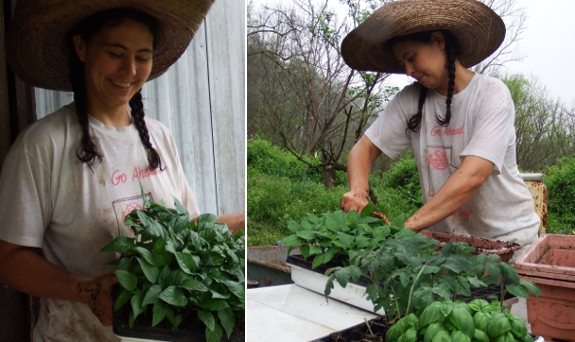
What better gardening
activity is there for a rainy day than potting up? I guess most people
don't actually do the work in the rain....
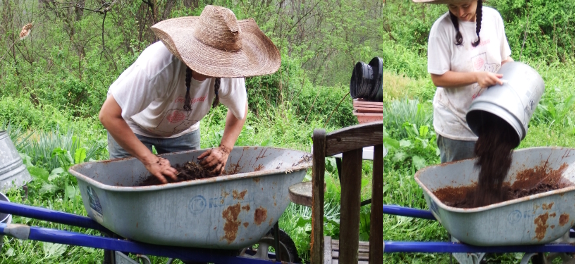
Even though I've
changed my loyalties from stump dirt to storebought potting soil for
the starting stage, I'm still content with homegrown options for
potting up. Half stump dirt and half well-aged horse manure gives
hungry plants plenty of nutrients while waiting for frost danger to
pass. And, at this age, there's no worry left about damping off.
The wheelchair chicken
tractor chickens seem to like their new home.
They spent the morning testing any possible escape routes and settled
down to happy grazing in the afternoon.
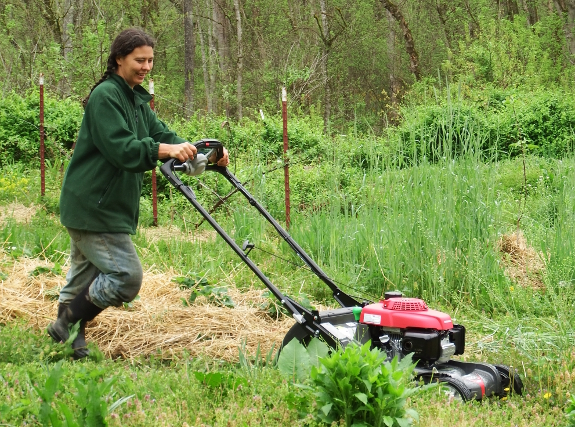
Now that everyone's done
drooling over Mark's new mower, I thought it might be helpful to share
our thought processes in choosing the new tool. A homestead like ours,
with grassy aisles between permanent garden beds covering a couple of
acres, needs a mower small and nimble enough to dive into nooks and
crannies...and preferably hefty enough to cut thick weeds and power up
slick hills without burning out or breaking its handlers. Here are the
mowers we've considered and/or tried.
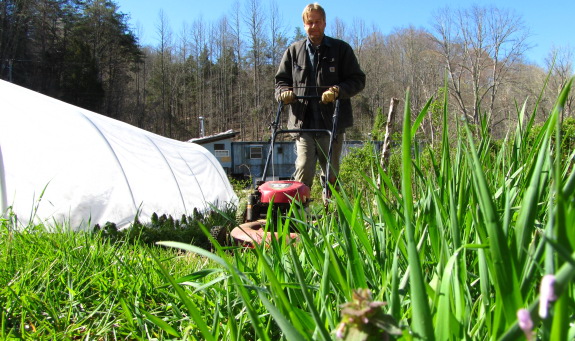 The Craftsman
917388571 was our
farm's second mower (replacing an ancient mower that literally exploded
one day when I asked it to do things mowers shouldn't be asked to do).
What I loved about this mower: it ran with minimal upkeep for eight
years after being purchased used and was easy enough for me to start
until the final season. What we didn't like so much: pushing it up
hills and around corners could wear you out, especially in the heat.
Meanwhile, as the Craftsman aged it seemed to go through flywheel shaft
keys and blades like candy despite there being fewer and fewer
obstructions left in its path.
The Craftsman
917388571 was our
farm's second mower (replacing an ancient mower that literally exploded
one day when I asked it to do things mowers shouldn't be asked to do).
What I loved about this mower: it ran with minimal upkeep for eight
years after being purchased used and was easy enough for me to start
until the final season. What we didn't like so much: pushing it up
hills and around corners could wear you out, especially in the heat.
Meanwhile, as the Craftsman aged it seemed to go through flywheel shaft
keys and blades like candy despite there being fewer and fewer
obstructions left in its path.
In fall 2014, I loosened the
purse strings and we upgraded to a Swisher. Mark was hoping that the
string cut would handle our rough terrain without so many flywheel
problems and he also thought a self-propelled mower would make
grass-cutting a breeze. I'll admit that I detested this mower from day
one. The string flung blades of grass into my garden beds, requiring
much more washing of our harvest (and making leaf lettuce completely
unpalatable), and the string also resulted in a rougher cut that wasn't
fun on bare feet. I couldn't start the machine either, so when it was
my turn to mow I stuck with the Craftsman.
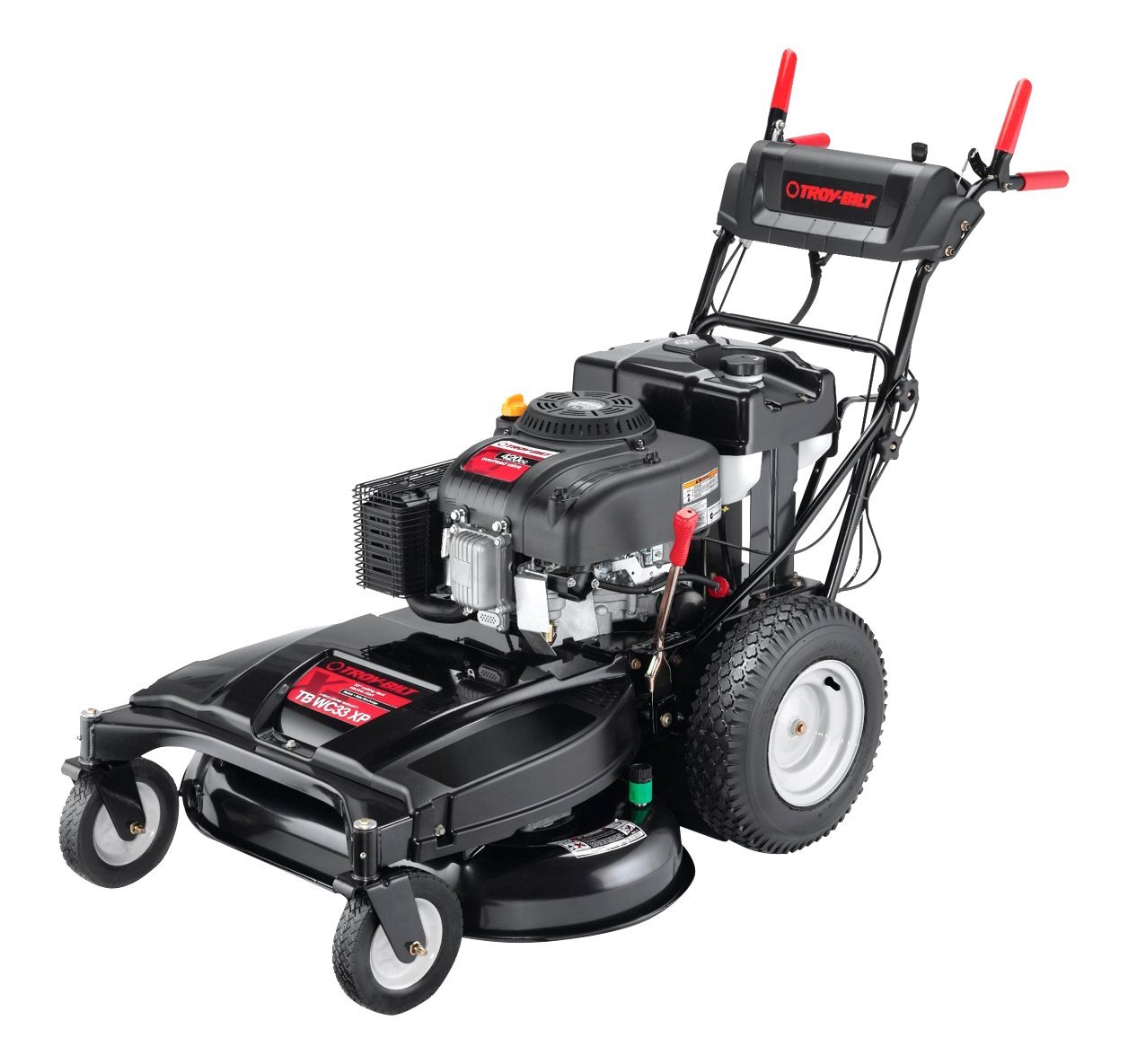 Once Mark gave up on the
dream of the Swisher, we put our heads together and tried to figure out
if there was a mower that would do what we each wanted. At first, we
considered a Troy-Bilt WC33. The price tag was daunting,
but such a hefty machine seemed like it might be a good idea,
especially with the electric start, self-propulsion, and excellent
reviews. But then I read deeper and realized that there was no way I
could manage the beast with my moderate upper-body strength. Luckily,
Mark was willing to compromise.
Once Mark gave up on the
dream of the Swisher, we put our heads together and tried to figure out
if there was a mower that would do what we each wanted. At first, we
considered a Troy-Bilt WC33. The price tag was daunting,
but such a hefty machine seemed like it might be a good idea,
especially with the electric start, self-propulsion, and excellent
reviews. But then I read deeper and realized that there was no way I
could manage the beast with my moderate upper-body strength. Luckily,
Mark was willing to compromise.
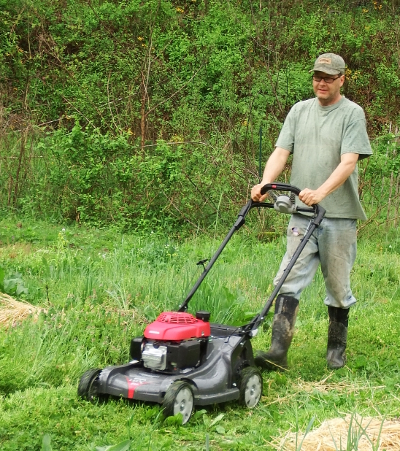 We settled on the Honda
HRX217K5VKA because it looked small enough for me to maneuver and
boasted the best reviews of any of the same-class mowers. After taking
it for a test drive, I have to admit, I'm sold. The auto-choke,
easy-start system almost seems like a magic trick --- I've never had a
two-stroke engine that I could rev up without even feeling it in my
yanking arm. The self-propulsion really makes a difference in our hilly
terrain (yes, Mark was right about that), and at the same time the
design makes it easy to go manual in extremely tight quarters.
We settled on the Honda
HRX217K5VKA because it looked small enough for me to maneuver and
boasted the best reviews of any of the same-class mowers. After taking
it for a test drive, I have to admit, I'm sold. The auto-choke,
easy-start system almost seems like a magic trick --- I've never had a
two-stroke engine that I could rev up without even feeling it in my
yanking arm. The self-propulsion really makes a difference in our hilly
terrain (yes, Mark was right about that), and at the same time the
design makes it easy to go manual in extremely tight quarters.
Of course, to pay for
itself, the Honda will need to last at least a decade. Here's hoping
our new mower will go the distance!
Anna's brother Joey has a discovered an easy way to mount a lightweight solar panel to the underside of his underground house.
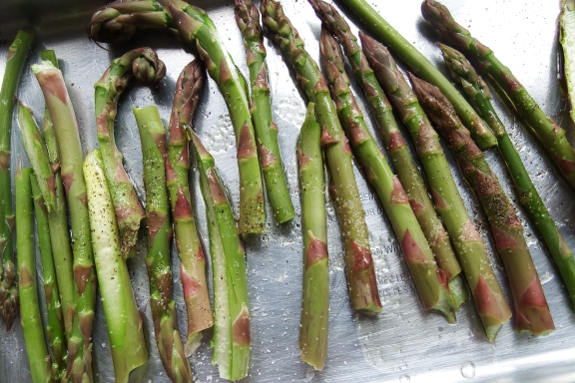
On the sixth straight
day of rain, the creek finally started to rise. The asparagus responded
a few days earlier, beginning to provide whole meals of spears around
day three. Tenacious weeds loosened their grip on the earth on day
four. And on day five, trees and bushes sudden seemed twice as green.
Gotta love spring rains
after a dry spell!
I mounted a 5 gallon bucket EZ miser
to the back of the wheelchair chicken tractor.
The weight helps to balance
out the heavy nest box in front.
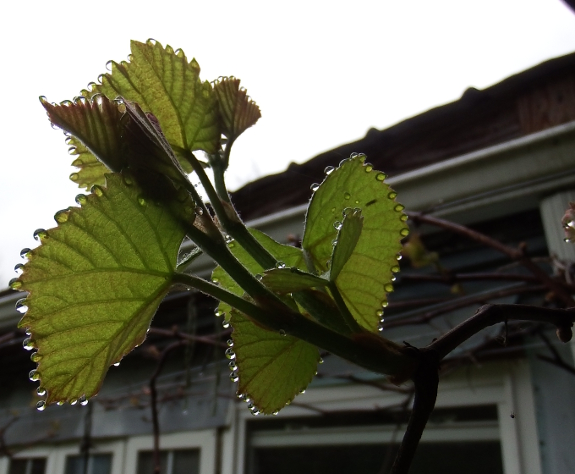
At a certain point, the
world is so wet that even Edgar doesn't want to go out and graze. So
the herd calls in takeaway.
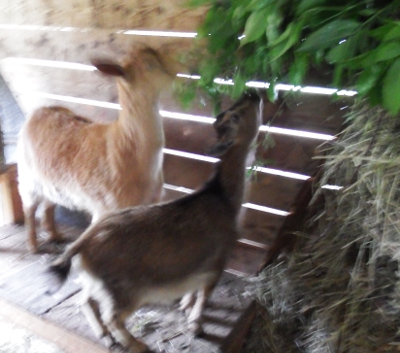
"I'd like a spring leaf
medley," Aurora told me. "Some elderberry, some pear prunings, a bit of
willow, maybe a small side order of honeysuckle and buckeye."
"And make it snappy,"
Edgar added. Did I really hear him mutter "It's hard to find good help
nowadays" under his breath?
We decided to add another 10
foot PVC run to the wheelchair chicken tractor.
I thought about making a long
20 foot PVC run but felt like it might be hard to move.
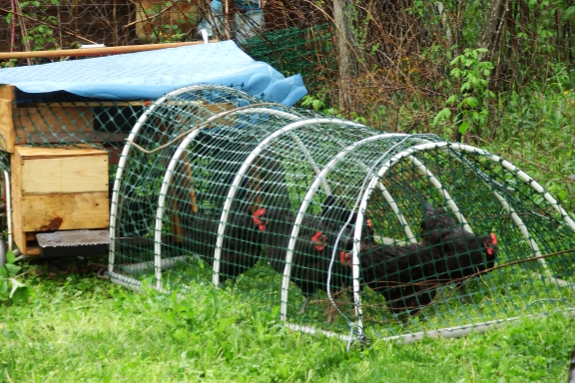
Even though we knew it
would slightly overload the new chicken
tractor with docking
run, we put all nine
coop hens inside so we wouldn't have more than two chicken areas to
monitor each day. That was a bit rough on the flock since the skies
opened up and proceeded to pour for the next several days, but the
girls seem to have stayed pretty dry while coming out to graze between
showers.
The roll-out
nest box, to our
surprise, has been the least successful part of the undertaking.
Without straw or a nest egg in the box, most of the hens have been
ignoring the structure and laying on the ground instead. Mark's
thinking of glueing a golf ball inside in hopes we can talk the hens
into utilizing the roll-out option. In the meantime, we've been
gathering muddy eggs out of the yard.
I attached a lightweight
plastic trash can to the docking end of the new PVC grazing pod
extension.
That makes it easy to push it
through a hole in the fence material to join the two runs.
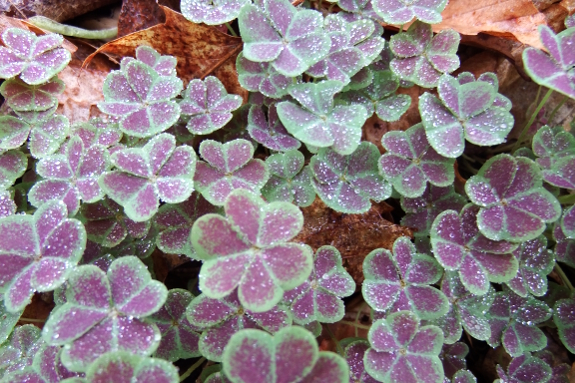
This week's flood didn't
quite match our biggest
one ever, but it
came close. Over five inches during a week (half in the last
twenty-four hours) is nothing to sneeze at.

The floodplain is so far
underwater that it feels like one huge, still lake.
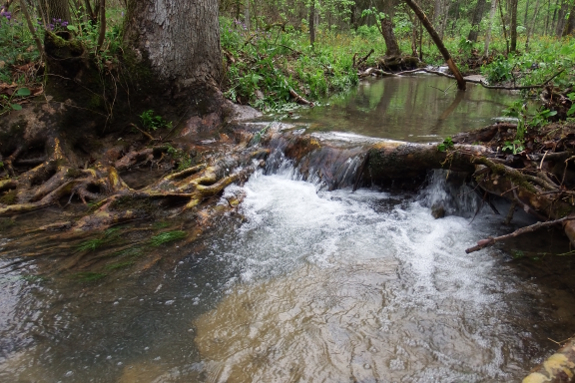
Mark was surprised that
the smaller creek didn't roar as loudly as it usually does during flood
times. After some reconnaissance, I figured out why --- the part of the
creek closest to our core homstead is part of the lake. I had to walk a
ways upstream to find flowing water.
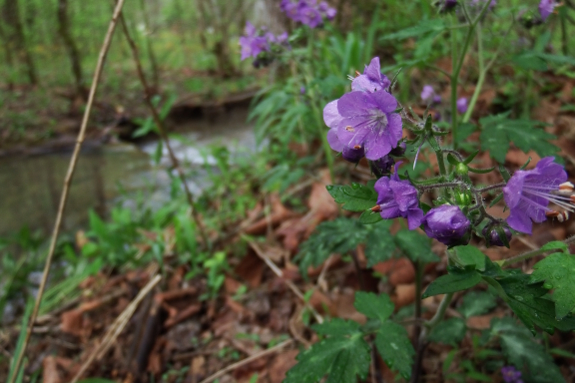
In the process, I
discovered a very heartening sight --- rocks! This small creek, for
some reason, had worn itself down to bare mud 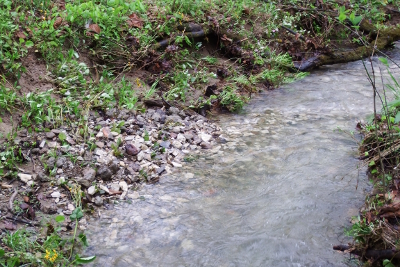 over
most of its length long before we moved in. The result is relentless
erosion that keeps cutting the bottom of the creek deeper every year.
over
most of its length long before we moved in. The result is relentless
erosion that keeps cutting the bottom of the creek deeper every year.
Not so any more, at
least for the upper expanses. Rocks as big as my fist were carried down
by the floodwaters and deposited in bends and pools. Maybe another big
flood or two will fix the bottom of the downstream portion of the creek
as well?
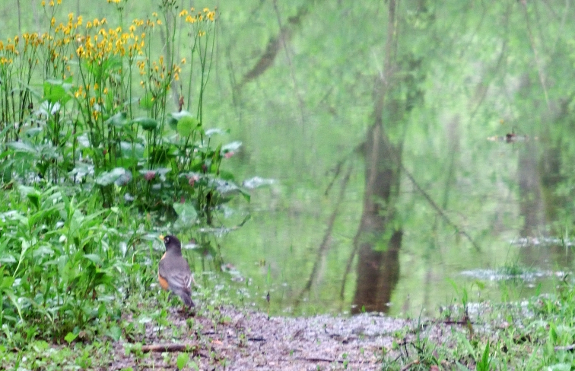
Anyone want to take bets
on how soon the floodwaters recede sufficiently to let us bring home
some fresh groceries? Good thing the freezers are still pretty full!
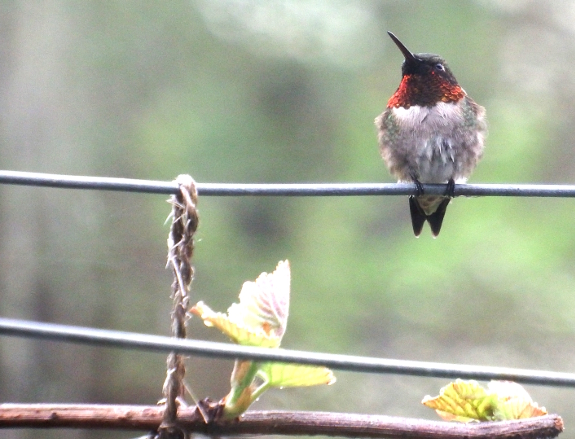
Although we did
eventually make it
across the creek Wednesday, our first attempt was a failure.
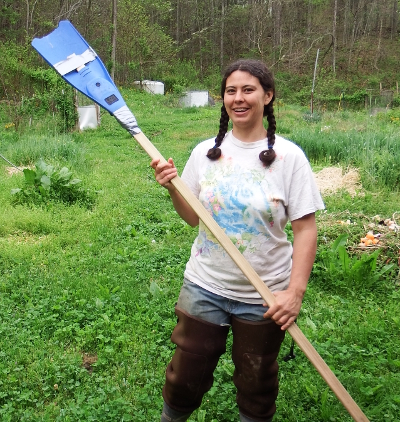 "If I just had a paddle, I
think it would be safe to kayak across the floodplain
while the water is so dispersed," I told Mark Wednesday morning. Within
fifteen minutes, he'd created me a paddle out of a flipper (thanks,
Rose Nell!), a furring strip, and some duct tape.
"If I just had a paddle, I
think it would be safe to kayak across the floodplain
while the water is so dispersed," I told Mark Wednesday morning. Within
fifteen minutes, he'd created me a paddle out of a flipper (thanks,
Rose Nell!), a furring strip, and some duct tape.
Unfortunately, when we
embarked on our adventure, Mark immediately saw the flaw in my plans.
Despite flood waters receding about three vertical feet in the last
twenty-four hours, I still couldn't reach the kayak using hip waders.
All it took was a little
more time, though, to achieve our goal. By 1 pm, the creek had gone
down another foot and Mark and I together were able to retrieve the
kayak we'd stashed by the creek. He hoisted it into a tree to empty out
the water (a difficult feat when knee-deep in the drink), and we even
discovered that we'd been smart enough to leave a paddle stashed
inside. Maybe next time we'll get yet smarter and park the flood-water
transportation device by the barn!
Moving the wheelchair chicken tractor at night is easy when everybody is roosting.
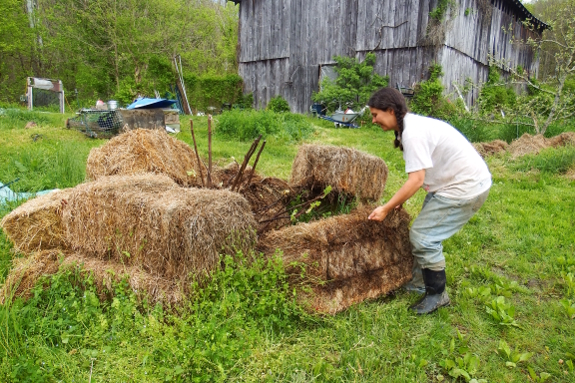
We tried two new methods
of protecting
our fig trees last fall. The one I apparently forgot to blog about
involved bending a young fig down so its branches sat directly on the
ground, then piling old garden weeds on top to produce an insulative
layer above which I layered a tarp for waterproofing. Despite reports
that this is the preferred method of winter-protecting a fig outside
its hardiness zone, our wet soil turned the attempt into a failure ---
anywhere fig branches touched the ground resulted in dead wood.
On the other hand, our hay
porcupine worked
like a charm. Granted, this past winter was warmer than usual, so it's
not an entirely fair comparison. But every branch survived and many are
pushing out new leaves. If I ever have that much leftover hay or straw,
I'll definitely repeat the trick again!
The roll out
nest box has proven itself to be a major, major innovation.
Our eggs have never been so
clean.
It's helped to alert us to a
problem hen who has figured out how to peck at an egg from the nest.
She can barely reach that far and must've been doing it before the roll
out nest box.
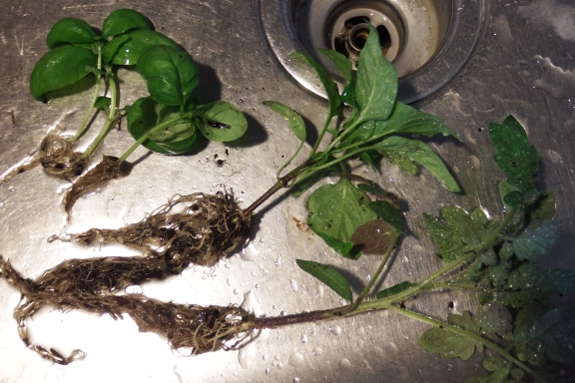
When I potted
up my summer seedlings
a week ago, I pulled out a few basil plants along with a pepper and
tomato to go in the aquaponics setup. First, I carefully washed
most of the dirt off their roots...
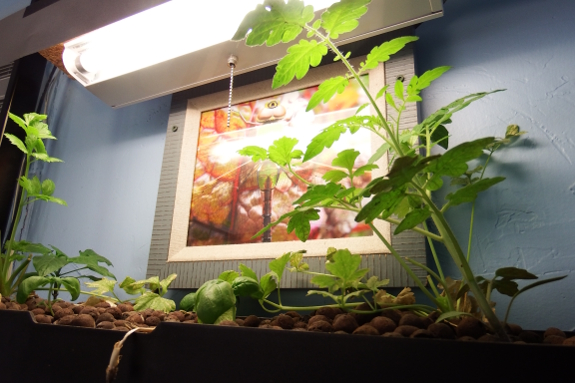
...then I inserted the
plants into the growing bed.
A week later, all are
still alive, and the tomato especially is thriving. I think this might
actually be a better way of planting into a grow bed than starting
seeds directly in rock wool --- the on/off cycle of the water flushing
through the bed is a little rough on young seedlings and seems to be
more appropriate for mid-sized plants.
Now to see if these
newcomers will live where everything except celery has thus far failed
to thrive.
The wheelchair chicken tractor is even easier to move with this shiny new handle.
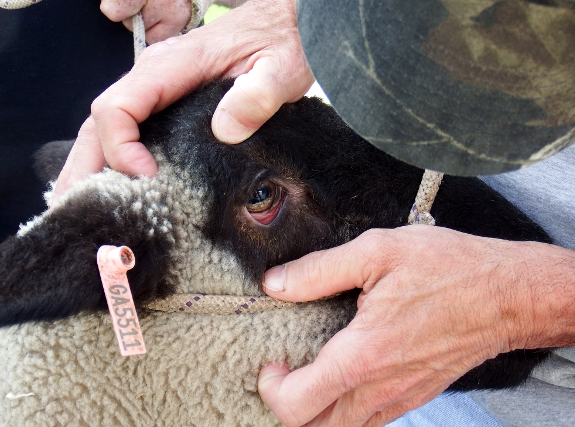
I spent the day Saturday
at another excellent sheep and goat workshop organized by the local
Extension Service. This one was specifically about internal parasites,
and I came home with a FAMACHA card so I can test for
barberpole-worm infestations the easy way on my home turf.
You'll need to attend a
workshop yourself if you'd like your own card, but I'll share an update
on the efficacy of chemical and non-chemical dewormers in a
later post. Stay tuned!
I caught the egg eating hen
in the act of trying to get to the eggs and closed her off to the rest
of the flock.
We were not ready to retire a
chicken on the weekend so I painted some of her back feathers with
white spray paint so we'll know who she is.
Want more in-depth information? Browse through our books.
Or explore more posts by date or by subject.
About us: Anna Hess and Mark Hamilton spent over a decade living self-sufficiently in the mountains of Virginia before moving north to start over from scratch in the foothills of Ohio. They've experimented with permaculture, no-till gardening, trailersteading, home-based microbusinesses and much more, writing about their adventures in both blogs and books.
